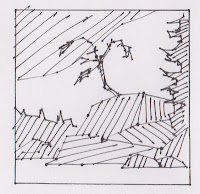Having recently finished two workshops (a five day Fundamentals for Landscape Painters and a two day Preparing for Plein air) I am again reminded how hard it is to hold onto the fundamentals and apply them in the heat of battle.
Lots of painters have little reminders. I have been thinking about one for a few weeks and tried it out in the workshops. It is my 6 Ws. It will probably evolve over the next while but it is a start that may be helpful for others.
These 6Ws are to be used during the planning stages. I encourage recording simple shapes to include in a thumbnail sketch, then organize the shapes into three or four values. I encourage making additional sketches using the 6Ws below to strengthen the first sketch. Every time you put pencil to paper and consider what to include or exclude and where to place things (WHATSITS) your composition will improve and your painting will move ahead more quickly and with confidence.
WHAT-WHY-WHERE-WHATSITS-WORDS-WHAMMIES
Know WHAT your painting is about
What is the centre of interest, etc . - the reason you have chosen to make the painting?
Know WHY you are attracted to paint the WHAT
What is it about the WHAT that attracts you? Might be the colour of light on it, the strong value contrasts, etc. Exaggerate the WHY to strengthen the WHAT
Know WHERE on your canvas your WHAT will be best and your composition will be strongest
Understand the guidelines used for placement - generally keeping your WHAT away from the middle of the painting.
Know the WHATSITS available to help support the WHAT and the WHY
Identify the objects or elements available in the scene that can be used to strengthen the compositon - clouds, trees, reflections, rocks, etc - that can be relocated, exaggerated , enlarged, etc and generally used as needed. They are all subordinate to the WHAT and can be handled as such but available as required
.
Choose WORDS to describe the painting - five or less
I have found it helpful to write down below my thumbnail sketches WORDS to describe what the painting is about or why I have painted it. These can be helpful during a self critique to see that you have simplified and that the painting is about what you intended. Can also help with the title.
Choose the two big WHAMMIES - colour and value dominance
The two big eye catchers that create emotional draw to your work are value and colour. Having clear dominance of one value and one colour most often makes for stronger paintings.
 |
| Simple flat two dimensional selection of shapes to include in composition |
 |
| Separate light values from combined midtone and dark values |
 |
| Divide midtones from darks |
Make additional sketches considering the 6Ws to strengthen the composition. If others have KISS systems that work for them, I would love to learn about them..
Cheers.

This is VERY helpful! Thank you! I drove around for an hour on Tuesday thinking I would paint plein air and just didn't know where to start. So I just came home and did a still life.
ReplyDelete